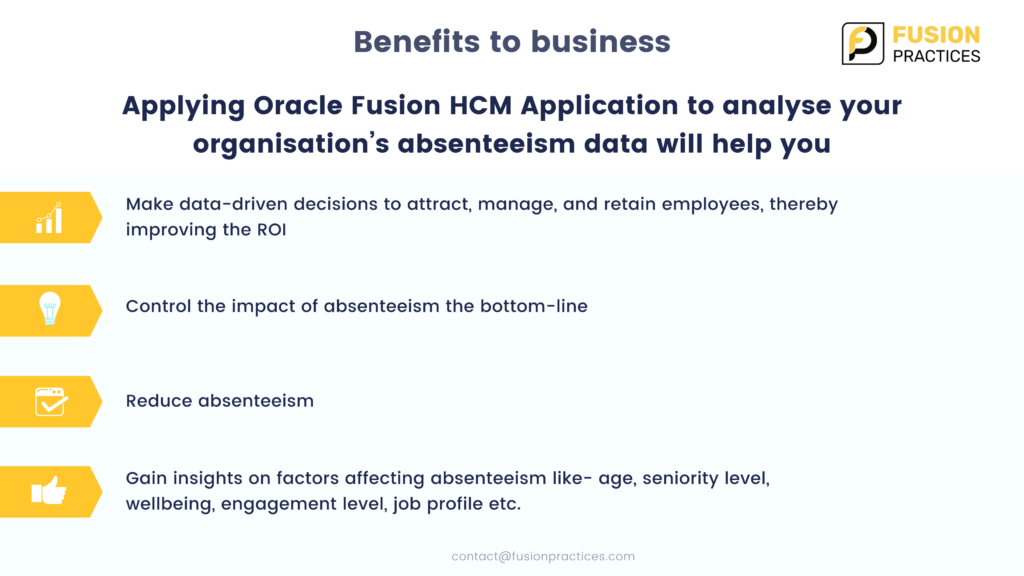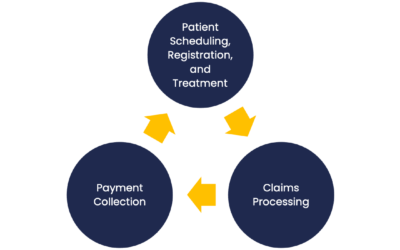Maximise workforce productivity using Oracle Fusion Human Capital Management (HCM)
Applying analytics to your absenteeism data can potentially help your organisation save thousands, if not millions of dollars. Oracle Fusion HCM Application uses Oracle Data Mining for workforce predictive analytics and helps companies eliminate unnecessary costs and increase workforce productivity and retention.
Absenteeism is a business challenge that many companies struggle to tackle. It impacts employee morale, hampers productivity, and leads to revenue loss.
Employee wellbeing is a key focus area for many organisations; optimisation of human resources and empowering them to reach their true potential is a challenge that many Chief Human Resources Managers face today. Various factors can impact employee productivity including absenteeism and workforce security regulations.
Consider the case of the Netherlands. The country offers a high level of social security and employee protection. For example, when an employee has a long-term physical or psychological disability, his or her company is obliged to pay the employee’s salary for up to 12 years. Some of these could also be due to work-related issues and are preventable because they are caused by, among other things, work pressure, stress, and conflicts with managers or colleagues. A severe burnout can prevent someone from working for a long time. This can potentially cost the organisation over $500,000. [1]
While absenteeism cannot be avoided entirely (seasonal or chronic illnesses), organisations would want to avoid scenarios like the ones described above. Long-term employee absenteeism and poor workforce productivity due to lack of engagement pose an enormous risk and have major cost impacts for employers. Applying HR analytics can help them mitigate such risks.
Here is a three-step roadmap that will help you apply analytics on your absenteeism data and potentially save thousands, if not millions of dollars, using Oracle Fusion Human Capital Management (HCM).
This model offers an understanding of the various parameters that affect individual employees and prognosticate their likely progress in the organisation. It also conducts a ‘what-if analysis’ to check the probable influence on employees through regulating HR factors such as days-off benefits, vacation goals, and bonus plans.

Step 1 : Monitor
In order to obtain a clear picture of the impact of absenteeism, organisations need to track and monitor it systematically. In the case of The Netherlands, strict regulations make it essential for companies to track absenteeism. This means that they already have access to detailed data than many companies in other countries.
Monitoring absenteeism closely offers many valuable insights. Firstly, companies can compare their scores with the rest of the market. Employees working for the best performing companies in the UK—in terms of absenteeism – have 3 days of absence per employee per annum on average. However, in the worst performing organisations, employees have an average of 9 days of absence per employee per annum.[1] Secondly, monitoring also helps identify areas that have a high incidence of absenteeism within the organisation.
Step 2 : Collect and analyse data
Preventable absenteeism is often the consequence of deeper issues, such as a conflict with a manager or work stress. Most companies use annual engagement and well-being surveys. Factors such as satisfaction, organisational commitment, work engagement, and well-being play an important role in both voluntary and involuntary absenteeism.
The next step is to analyse the absenteeism data in order to find what causes it. This helps in identifying cause-and-effect relationships. For example, higher levels of engagement are associated with a lower frequency of absence.
Step 3 : Take action
The moment you identify the causes for absenteeism, you will be able to proactively reduce and prevent it. Different causes require different solutions. Absenteeism caused by work stress needs to be handled differently from that caused by a conflict with supervisors. For example, research shows that employees cope with stress much better when they have the autonomy, social support, and opportunities for personal growth. Absenteeism caused by a conflict with one’s supervisor must be resolved differently.
Monitoring and analysing absenteeism not only helps organisations to get a grip on factors impacting employee productivity but can also potentially save millions of dollars for them.

[1] https://www.analyticsinhr.com/blog/absenteeism-3-step-analytics-approach/
[2] https://hranalytics.live/2019/11/22/hr-analytics-for-reducing-absenteeism-at-work/



